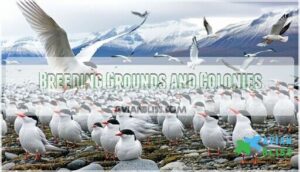This site is supported by our readers. We may earn a commission, at no cost to you, if you purchase through links.

This small seabird, sporting a sharp black cap and slender wings, travels about 44,000 miles each year—literally from pole to pole.
You’ll find arctic terns nesting in the far north during summer, then heading south to Antarctic seas for winter.
Their migration is the longest of any animal, and they use the wind to glide efficiently, saving energy on their epic journey.
With keen eyesight and agile flight, they snatch fish from the water.
Curious how these globe-trotters survive such extremes? There’s more to their story ahead.
Table Of Contents
- Key Takeaways
- Arctic Tern Classification
- Migration Patterns
- Habitat and Distribution
- Behavior and Adaptations
- Conservation Status
- Frequently Asked Questions (FAQs)
- What is special about Arctic terns?
- How far do Arctic terns fly in a year?
- What is special about Arctic tern?
- Do Arctic terns sleep while flying?
- Do Arctic terns mate for life?
- Where do Arctic terns go in winter?
- How long do arctic terns live?
- What do arctic tern chicks look like?
- How do arctic terns navigate?
- What do arctic terns eat?
- Conclusion
Key Takeaways
- You’ll witness the longest migration in the animal kingdom as arctic terns travel 44,000 miles annually from Arctic breeding grounds to Antarctic waters, experiencing two summers each year.
- You can identify these seabirds by their distinctive black cap, red bill and legs during breeding season, plus their deeply forked tail and angular wings that make them efficient long-distance fliers.
- You’ll find arctic terns using sophisticated navigation methods including magnetic field detection, celestial cues, and coastal landmarks to complete their pole-to-pole journeys with remarkable accuracy.
- You should know that climate change poses the biggest threat to arctic terns as warming temperatures shift their food sources and alter ice formation timing in both polar regions, affecting their breeding success.
Arctic Tern Classification
You’ll recognize the Arctic tern (Sterna paradisaea) as a small, elegant seabird belonging to the Laridae family within the order Charadriiformes.
This graceful bird measures 11-15 inches long with a 26-30 inch wingspan, featuring distinctive gray-and-white plumage, angular wings, and a deeply forked tail that sets it apart from other tern species.
Scientific Name and Family
You’ll find the Arctic Tern classified under the scientific name Sterna paradisaea, belonging to the Laridae family within the Charadriiformes order.
This bird taxonomy places it squarely in the tern group, where it’s earned recognition as one of nature’s most remarkable travelers.
The Laridae family includes gulls and terns, making Arctic Terns part of a diverse seabird classification system that helps scientists understand their evolutionary relationships and behaviors.
Physical Description and Size
You’ll immediately notice the Arctic Tern’s compact yet elegant build.
These slender seabirds measure 11-15 inches in length with a 26-30 inch wingspan, weighing just 3-4 ounces.
Their body proportions feature angular wings, short red legs, and a steep forehead.
Size comparison places them between robins and crows, with distinctive wing morphology perfect for long-distance flight.
Distinctive Features and Plumage
You’ll recognize Arctic Terns by their distinctive plumage variation between seasons.
Breeding adults sport a striking black cap, blood-red bill, and matching red legs against white bodies with gray upperparts.
Their deeply forked tail shape creates an elegant silhouette during flight.
Juvenile markings differ substantially, featuring white foreheads, short black bills, and sooty patches from eye to nape.
These markings differ from the similar reddish bill of terns, which is a key point to note for accurate identification and understanding of these birds’ plumage characteristics.
Migration Patterns
You’ll witness nature’s most incredible journey when you follow Arctic terns on their epic annual migration from Arctic breeding grounds to Antarctic waters.
These remarkable birds cover up to 44,000 miles each year, experiencing two summers and more daylight than any other species on Earth, which makes their journey truly incredible.
Annual Migration Route
Arctic terns follow bird migration patterns that span both hemispheres in their longdistance migration between Arctic breeding grounds and Antarctica.
Migration triggers include daylight changes and food availability, prompting these remarkable journeys. Their route variations depend on ocean conditions and stopover locations where productive feeding occurs.
The arctic tern’s navigation methods include:
- Magnetic compass sensing – detecting Earth’s magnetic fields for directional guidance
- Celestial navigation – using sun and star positions during flight
- Coastal landmark recognition – following familiar shorelines and island chains
- Ocean current awareness – utilizing favorable winds and water movements
Energy expenditure remains efficient through strategic rest periods at key feeding zones mid-ocean.
Many threats such as habitat destruction impact their routes.
Distance Covered and Timing
Covering a staggering 44,000 to 59,000 miles each year, the arctic tern sets the gold standard for longdistance migration.
You’ll see them follow winding migration routes, adjusting their speed with the seasons—spring brings faster Migration Speed, while fall is more leisurely.
Stopover Duration varies, but their Lifetime Distance can reach three trips to the Moon, showcasing remarkable avian navigation.
They’re listed as a species of least concern, despite a decreasing population.
Migration Techniques and Stopovers
The arctic tern doesn’t fly straight lines during its epic seabird migration.
These master navigators zigzag between hemispheres, using Navigation Strategies that optimize Route Optimization for maximum feeding opportunities.
Weather Influence shapes their longdistance journey as they pause at productive ocean hotspots for up to 25 days.
Energy Conservation drives their Stopover Ecology, with avian navigation guiding them to krill-rich waters that fuel their remarkable migration routes, utilizing effective Route Optimization.
Habitat and Distribution
You’ll find Arctic terns nesting in dense colonies across Arctic and subarctic coasts, tundra, and islands during the breeding season.
After breeding, they migrate to Antarctic waters, covering nearly every ocean and visiting the coasts of all continents each year, which involves traveling to almost every part of the world, making them one of the most mobile species.
Breeding Grounds and Colonies
Following their epic migration journeys, you’ll find these remarkable seabirds establishing breeding grounds across Arctic coastlines and tundra regions.
Arctic terns form colonies ranging from several pairs to tens of thousands, demonstrating impressive site fidelity by returning to natal locations annually.
Colony defense becomes fierce during nesting rituals, with coordinated attacks protecting ground-scrape nesting sites.
Chick development occurs within these protective bird colonies, where both parents share duties across the colony’s structured social network, and this is a key aspect of their colony defense and overall breeding grounds.
Wintering Areas and Coastal Sites
After completing their Arctic breeding season, these coastal birds set out on their journey to Antarctic Havens, where they’ll spend the southern summer months.
Their Coastal Reliance becomes evident as they:
- Follow specific bird migration routes along productive ocean currents
- Target krill-rich waters near Antarctic ice shelves for the best Winter Diet
- Demonstrate remarkable Site Fidelity to proven feeding areas despite Habitat Loss
These migratory birds face increasing challenges as warming waters alter traditional coastal North America departure points, affecting their carefully timed bird distribution patterns, which showcases their Coastal Reliance.
Geographic Range and Population
You’ll find the arctic tern’s global distribution stretches across the Arctic and sub-Arctic, with breeding grounds from Alaska to Scandinavia.
Population density peaks in places like Iceland and Canada, but range shifts and habitat loss challenge some colonies.
Bird migration routes span continents, making population genetics a puzzle.
Despite declines in spots, this bird’s overall distribution remains strong.
Their epic migrations take them to Antarctic waters.
Behavior and Adaptations
You’ll discover that Arctic terns have developed remarkable behavioral adaptations that enable their record-breaking migrations and successful survival across polar environments.
These birds exhibit sophisticated feeding techniques, complex social behaviors, and specialized nesting strategies that make them one of nature’s most resilient travelers.
Feeding Techniques and Diet
You’ll witness Arctic terns using plunge-diving and surface-skimming for prey capture, primarily targeting small fish like sandlances and herring under six inches.
Their diet composition includes crustaceans, marine worms, and insects on breeding grounds.
These foraging strategies involve hovering before diving, plus kleptoparasitism—stealing from other seabirds.
Chick diet emphasizes krill and amphipods for ideal growth, and more information on their specialized dietary needs can be found online, highlighting the importance of understanding Arctic tern habits.
Nesting and Reproduction Habits
Arctic tern breeding begins when pairs return to familiar nesting sites around age three or four.
These remarkable seabirds demonstrate fascinating reproductive behaviors that guarantee species survival.
Mating Rituals and Egg Laying:
- Males perform elaborate courtship displays, presenting fish gifts to prospective mates while executing aerial acrobatics
- Pairs create simple ground scrapes lined with grass or pebbles, typically laying 1-3 buff-colored eggs with dark blotches
- Both parents share incubation duties for approximately 21-24 days, taking turns warming their precious cargo
- Chick Development progresses rapidly, with young leaving nests within 1-3 days but remaining dependent on Parental Care for 1-2 months.
They often use specific materials for their nests.
Social Interactions and Colony Life
Beyond nesting, Arctic terns form highly social colonies with fascinating interactions.
You’ll observe strict Colony Defense strategies where hundreds coordinate attacks against intruders.
Communication Signals include specific calls for danger, food, and territorial disputes.
Group Foraging occurs during peak fishing times, with experienced birds leading younger ones to productive waters.
| Social Behavior | Colony Function |
|---|---|
| Pair Bond Formation | Lifelong partnerships with coordinated nest site selection |
| Parental Care Sharing | Both parents rotate incubation and chick feeding duties |
| Social Hierarchy Systems | Experienced breeders claim prime nesting locations first |
| Cooperative Breeding Networks | Neighboring pairs assist with predator warnings and defense |
Conservation Status
You’ll find that Arctic terns face a mixed conservation picture, with populations declining steadily at the southern edges of their Atlantic Coast breeding range.
While remaining stable across most of their remote Arctic territories, climate change poses the greatest long-term threat to these remarkable migrants.
As warming temperatures shift their food sources and alter the timing of ice formation in both Arctic and Antarctic regions, it becomes a significant concern for their survival, highlighting the need to address conservation efforts.
Population Trends and Threats
After exploring the terns’ social lives, you’ll notice their population trends aren’t all smooth sailing.
Habitat loss, food scarcity, and predation pressure chip away at colony numbers.
Pollution effects and direct human impacts add to the threats, making conservation a growing concern.
Climate impacts further complicate the population status, with many regions seeing local declines and shifting breeding success.
You can research ways to help with tern population decline, focusing on population trends and habitat loss.
Climate Change Impacts and Effects
Climate change poses serious threats to Arctic terns through habitat loss and polar ice melting.
You’ll see migration shifts as warming temperatures force birds northward, disrupting traditional breeding grounds.
Breeding success drops dramatically—up to 50% in some colonies—when extreme weather events flood nests or create heatwaves.
Food availability becomes unpredictable as warming oceans alter prey distributions, forcing longer foraging trips during critical chick-rearing periods, affecting overall breeding success.
Conservation Efforts and Protection Measures
Through coordinated conservation efforts, you’ll find habitat preservation initiatives protecting nesting colonies from human disturbance.
Protected areas now safeguard critical breeding sites while fishing regulations guarantee adequate food supplies.
Climate mitigation strategies address warming temperatures affecting migration timing.
Reducing pollution efforts target plastic waste and pesticides threatening Arctic tern survival.
Bird conservation programs employ predator control, translocation projects, and international agreements for thorough species protection and effective threat mitigation across their range.
Understanding their status requires evaluating their IUCN Red List criteria.
Frequently Asked Questions (FAQs)
What is special about Arctic terns?
Imagine a feathered frequent flyer earning three million miles – that’s what you’d get with an Arctic tern.
These remarkable seabirds hold the record for Earth’s longest migration, traveling roughly 44,000 miles annually from Arctic to Antarctic, experiencing two summers yearly.
How far do Arctic terns fly in a year?
Arctic terns fly incredible distances annually, covering 44,000 to 59,000 miles during their round-trip migration from Arctic breeding grounds to Antarctic waters, making it nature’s longest migration.
What is special about Arctic tern?
You’ll find these incredible birds hold the migration record – flying up to 59,000 miles yearly from Arctic to Antarctic, experiencing two summers and gaining more daylight than any other species.
Do Arctic terns sleep while flying?
You might wonder if terns nap on the wing, but there’s no scientific proof that they sleep while flying.
Instead, they rest on water or ice during migration stops, catching quick naps before continuing their marathon journey, which can be considered a marathon.
Do Arctic terns mate for life?
Like faithful compass roses pointing toward true north, these seabirds commit to lifelong partnerships.
You’ll find Arctic terns do mate for life, returning together to their natal colonies each breeding season with remarkable fidelity.
Where do Arctic terns go in winter?
When winter’s chill sets in, you’ll spot these birds heading south, all the way to Antarctica.
They chase summer, crossing oceans and continents, spending months in the Antarctic’s endless daylight before returning north when spring calls them home.
How long do arctic terns live?
Like ancient mariners who’ve weathered countless storms, you’ll find these resilient seabirds regularly reach 20-30 years, with some individuals surviving at least 34 years in the wild.
What do arctic tern chicks look like?
Arctic tern chicks are fluffy, downy creatures with mottled grayish-brown and white plumage that provides excellent camouflage.
They’ve short black bills, white foreheads, and distinctive sooty-colored patches extending from their eyes to the nape of their necks.
How do arctic terns navigate?
Brilliant birds blend biological brilliance with magnetic mastery.
You’ll find they use photoperiods, celestial cues, and Earth’s magnetic field.
These feathered navigators follow the sun like seasoned travelers, expertly combining multiple compass systems for their epic polar journeys.
What do arctic terns eat?
These seabirds feast primarily on small fish like sandlances, herring, and cod under six inches long.
They’ll also snack on krill, amphipods, small crabs, and insects, diving gracefully to snatch prey from ocean surfaces.
Conclusion
Imagine watching a tiny bird weighing just four ounces preparing for a journey that would challenge even the most experienced pilot—this is the reality for every arctic tern.
These remarkable seabirds demonstrate nature’s incredible capacity for endurance and adaptation. From their pole-to-pole migrations to their specialized hunting techniques, arctic terns prove that size doesn’t determine survival ability.
You’ve learned how these extraordinary birds navigate vast oceans, time their breeding perfectly, and face modern conservation challenges.
Their story reminds us that even the smallest creatures can achieve the most extraordinary feats.











